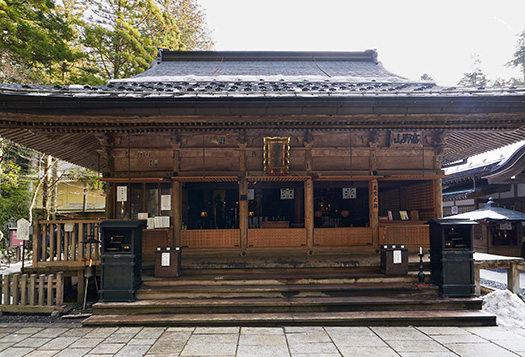

さて長々と書き連ねてきた「高野山探訪記」ですが、
ようやく「奥の院」建物に到着であります。
こころなしか「おお、よく来たな(笑)」みたいなレスを感じる心境。
住宅がメインでいろいろな探索をすることがライフワークになってきましたが、
宗教建築というのはさまざまに住環境に強い影響を与えてきた。
日本家屋で古民家を見て歩けばほぼ均一に仏壇、仏間に出会う。
人間は動物的生存を基本に生きる存在だけれど、
同時に「こころ」という不可解なものを抱き続けながら生きる。
考えるとか、判断するとか、願うとかのふしぎな脳活動と共生している。
日本人は神社という透明に近い宗教空間を尊崇しながら
同時に仏教思想での涅槃、解脱という救済も希っている。
神社信仰は他を排除する性向が少ない信仰心で仏教とも平和共存してきた。
「神さま、仏様」と違和感なく日本人はこころで唱え続けてきた。
空海さんの仏道にはどうもこの在来の神社信仰との合一性部分を感じる。
八十八ヵ所巡りのルーツには空海さんの山岳跋渉修行があるように思う。
日本は非常に山岳地形が特徴的な風土であり、
「みさき」というような言葉には抜けがたく自然崇拝的信仰が基底にある。
大陸的なインド、中国で発祥した仏教がこの日本の風土に出会ったとき、
空海さんのような修験道的な修行者が現れて密教を広布したのは
民族的必然性が強く働いたように思えるのです。
かれが活躍した時代は、仏教伝来から3-400年経過した時代であり、
そうした輸入仏教がいかにも「大陸由来」的な行き詰まりが顕著になって
天皇王権自体がその桎梏に満ちた「奈良の都」から脱出して
京都に首都移転した時代に相当している。
鎮護国家思想の背骨として王権は仏教を導入したけれど、
その教条の意固地さ,頑迷さに振り回されて事実上、制御不能になっていた。
そういう仏教のこの国での行き詰まり期にあらたな風を巻き起こしたのが
空海であり、最澄だったのでしょう。
最澄は比叡山という京都に近接するいかにも枢要の地に本拠を構えたけれど
より在野的な野生を感じさせる空海は政治の中心地からは隔絶した
空中宗教都市をあらたにこの高野山に切り開いていった。
どうもそういう違いが明確だと思われます。
奥の院を見学していたら、修行僧のみなさんが
どうやら空海さんの廟所に向かって讃を唱えられている場面に遭遇した。
はるかな衆生として空海さんにすこし近づけたように思えてうれしかった。
どうもわたし、熱心な空海ファンになってきたのかなぁ(笑)。
English version
[Mr. Kukai, who is still alive, visited Mt. Koya-16]
By the way, the “Koyasan expedition” that I have written for a long time,
We have finally arrived at the “Okunoin” building.
I feel like “Oh, I’ve come often (laughs)”.
It has become my lifework to explore various things mainly in housing,
Religious architecture has had a strong impact on the living environment in various ways.
If you look at an old folk house in a Japanese house, you will meet Buddhist altars and Buddhist altars almost evenly.
Human beings live on the basis of animal survival,
At the same time, he lives while holding the mysterious thing called “heart”.
It coexists with mysterious brain activities such as thinking, judging, and wishing.
While the Japanese respect the almost transparent religious space of a shrine
At the same time, the relief of nirvana and liberation in Buddhist thought is rare.
Shinto shrine beliefs have coexisted peacefully with Buddhism with a belief that has little tendency to exclude others.
The Japanese have continued to sing with their hearts without any discomfort with “God, Buddha.”
Kukai-san’s Buddhism seems to have a unity with this traditional shrine belief.
I think that Kukai-san’s mountain pilgrimage training has its roots in visiting 88 places.
Japan has a very mountainous terrain, and
Words such as “Misaki” are based on a belief in nature worship.
When Buddhism, which originated in continental India and China, encountered this Japanese climate,
It was the reason why Shugendo practitioners like Kukai appeared and spread esoteric Buddhism.
It seems that ethnic necessity worked strongly.
The time when he was active was 3-400 years after the introduction of Buddhism.
Such imported Buddhism has become a prominent “continental origin” deadlock.
The emperor’s kingship itself escaped from the “city of Nara” full of swords
He corresponds to the time when he moved to Kyoto.
Although the kingship introduced Buddhism as the backbone of the national ideology of protection,
Being swayed by the stubbornness and stubbornness of the doctrine, it was virtually out of control.
It was the one that caused a new wind during the deadlock period in this country of Buddhism.
It was Kukai, and it was probably Saicho.
Saicho was based in Mt. Hiei, a very important place near Kyoto.
Kukai, which makes you feel more wild and wild, is isolated from the political center
A new aerial religious city was opened up on Mt. Koya.
It seems that such a difference is clear.
When I was touring the Okunoin, the monks
Apparently, I encountered a scene where he was chanting to the mausoleum of Mr. Kukai.
I was happy to think that I was a little closer to Kukai-san as a far-reaching sentient being.
I wonder if I’ve become an avid Kukai fan (laughs).
Posted on 11月 12th, 2021 by 三木 奎吾
Filed under: 住宅マーケティング, 日本社会・文化研究








コメントを投稿
「※誹謗中傷や、悪意のある書き込み、営利目的などのコメントを防ぐために、投稿された全てのコメントは一時的に保留されますのでご了承ください。」
You must be logged in to post a comment.